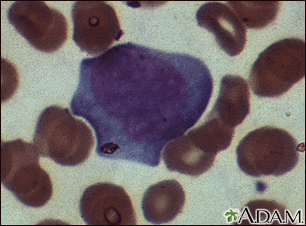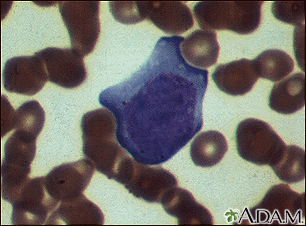Acute cytomegalovirus (CMV) infection
CMV mononucleosis; Cytomegalovirus; CMV; Human cytomegalovirus; HCMV
Cytomegalovirus (CMV) infection is a disease caused by a type of herpes virus.

This so-called Downy cell is typical of lymphocytes infected by EBV (Epstein Barr Virus) or CMV (Cytomegalovirus) in infectious mononucleosis. Downy cells may be classified as types I, II, or III. This is a type II Downy cell.

This is a lymphocyte that has been infected by the Epstein-Barr Virus (EBV) or Cytomegalovirus (CMV) in infectious mononucleosis and is referred to as a Downy cell. Downy cells may be classified as types I, II, or III. this is a type I Downy cell.

Infectious mononucleosis is caused by the Epstein-Barr virus. It is a viral infection causing high temperature, sore throat, and swollen lymph glands. Infectious mononucleosis can be contagious if the infected person comes in close or intimate contact with another person through saliva or sexual contact.

Algunos de los síntomas de la mononucleosis son inflamación de los ganglios linfáticos, ardor de garganta, fatiga y dolor de cabeza. Esta enfermedad es causada por el virus Epstein-Barr y, generalmente, es autolimitante. La mayoría de los pacientes se recupera espontáneamente en 4 a 6 semanas sin medicamentos.

This picture shows large, atypical lymphocytes (white blood cells). These cells are seen in viral infections, most commonly caused by the Epstein-Barr virus (infectious mononucleosis), cytomegalovirus diseases, and occasionally infectious hepatitis. This is an example of a type I Downy cell.

Infectious mononucleosis is caused by the Epstein-Barr virus. In teenagers and young adults, there is frequently a sore throat and red tonsils with whitish spots (exudate), as seen in this picture. Enlarged lymph nodes and fatigue are also common.

Antigens are large molecules (usually proteins) on the surface of cells, viruses, fungi, bacteria, and some non-living substances such as toxins, chemicals, drugs, and foreign particles. The immune system recognizes antigens and produces antibodies that destroy substances containing antigens.
Causes
Infection with CMV is very common. The infection is spread by:
- Blood transfusions
- Organ transplants
- Respiratory droplets
- Saliva
- Sexual contact
- Urine
- Tears
Most people come into contact with CMV in their lifetime, often early in life. But usually, people with a weakened immune system, such as those with HIV/AIDS, become ill from CMV infection. Some otherwise healthy people with CMV infection develop mononucleosis-like symptoms.
CMV is a type of herpes virus. Similar to all herpes viruses, CMV remains in your body for the rest of your life after infection. If your immune system becomes weakened in the future, this virus may have the chance to reactivate, causing symptoms.
Symptoms
Many people are exposed to CMV early in life, but do not realize it because they have no symptoms, or they have mild symptoms that resemble the common cold or flu. These may include:
- Enlarged lymph nodes, especially in the neck
- Fever
- Fatigue
- Loss of appetite
- Malaise
- Muscle aches
- Rash
- Sore throat
CMV can cause infections in different parts of the body. Symptoms vary depending on the area that is affected. Examples of body areas that can be infected by CMV are:
- The lungs
- The stomach or intestine
- The back of the eye (retina)
- A baby while still in the womb (congenital CMV)
Exams and Tests
Your health care provider will perform a physical exam and feel your belly area. Your liver or spleen may be enlarged or tender when they are gently pressed (palpated). You may have a skin rash.
Special lab tests such as a CMV DNA serum PCR test may be done to check for the presence of substances produced by CMV in your blood. Tests, such as a CMV antibody test, may be done to check the body's immune response to the CMV infection.
Other tests may include:
- Blood tests for platelets and white blood cells
- Chemistry panel
- Liver function tests
- Monospot test (to distinguish from mononucleosis due to Epstein-Barr virus infection)
Treatment
Most people recover in 4 to 6 weeks without medicine for CMV. Rest is needed, sometimes for a month or longer to regain full activity levels. Painkillers and warm salt-water gargles can help relieve symptoms.
Antiviral medicines and antibody therapy are usually not used in people with healthy immune function, but may be used for people with an impaired immune system.
Outlook (Prognosis)
The outcome is good with treatment. The symptoms may be relieved in a few weeks to months.
Possible Complications
Throat infection is the most common complication. Rare complications include:
- Colitis (infection and inflammation of the large intestine)
- Guillain-Barré syndrome
- Nervous system (neurologic) complications
- Pericarditis or myocarditis
- Pneumonia
- Rupture of the spleen
- Inflammation of the liver (hepatitis)
When to Contact a Medical Professional
Contact your provider for an appointment if you have symptoms of CMV infection.
Go to the emergency room or call 911 or the local emergency number if you have sharp, severe sudden pain in your left upper abdomen. This could be a sign of a ruptured spleen, which may require emergency surgery.
Prevention
CMV infection can be contagious if the infected person comes in close or intimate contact with another person. You should avoid kissing and sexual contact with an infected person.
The virus may also spread among young children in day care settings.
When planning blood transfusions or organ transplants, the CMV status of the donor can be checked to avoid passing CMV to a recipient who has not had CMV infection.
References
Boivin G, Limaye AP. Cytomegalovirus. In: Goldman L, Cooney KA, eds. Goldman-Cecil Medicine. 27th ed. Philadelphia, PA: Elsevier; 2024:chap 347.
Britt WJ. Cytomegalovirus. In: Bennett JE, Dolin R, Blaser MJ, eds. Mandell, Douglas, and Bennett's Principles and Practice of Infectious Diseases. 9th ed. Philadelphia, PA: Elsevier; 2020:chap 137.
Centers for Disease Control and Prevention website. Cytomegalovirus (CMV) and congenital CMV infection. Clinical overview of CMV and congenital CMV.
Version Info
Last reviewed on: 8/29/2024
Reviewed by: Jatin M. Vyas, MD, PhD, Roy and Diana Vagelos Professor in Medicine, Columbia University Vagelos College of Physicians and Surgeons, Division of Infectious Diseases, Department of Medicine, New York, NY. Also reviewed by David C. Dugdale, MD, Medical Director, Brenda Conaway, Editorial Director, and the A.D.A.M. Editorial team.
